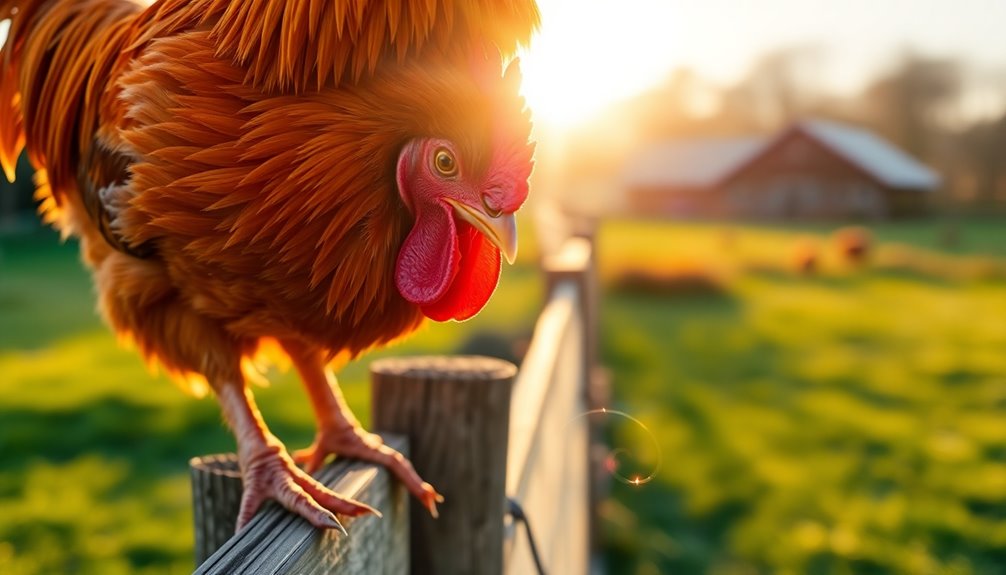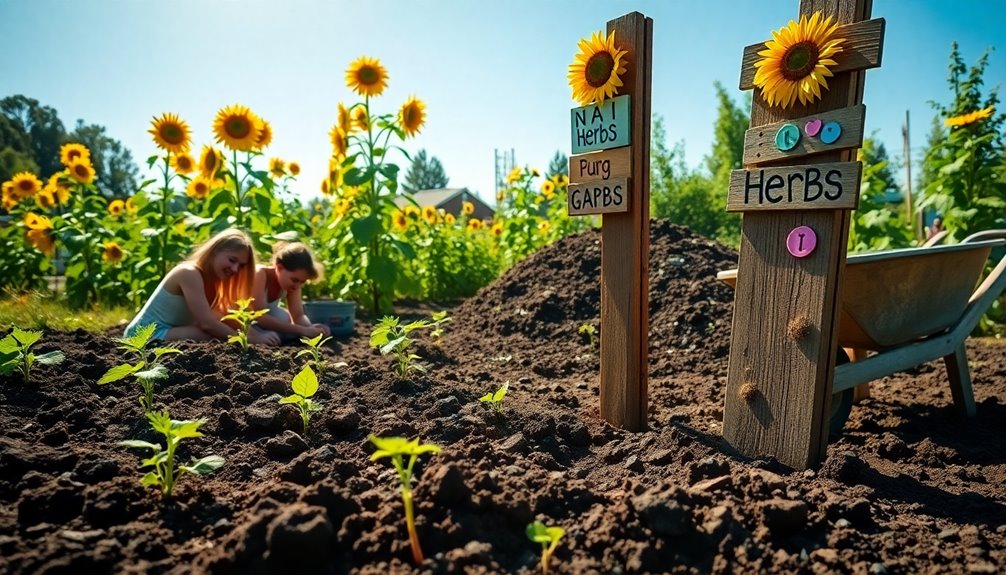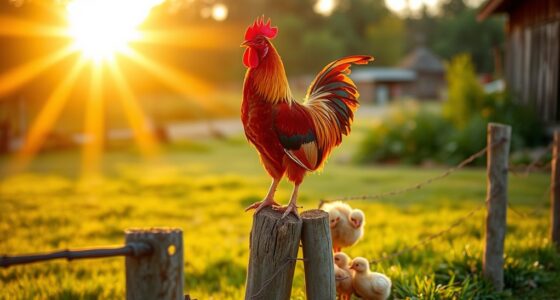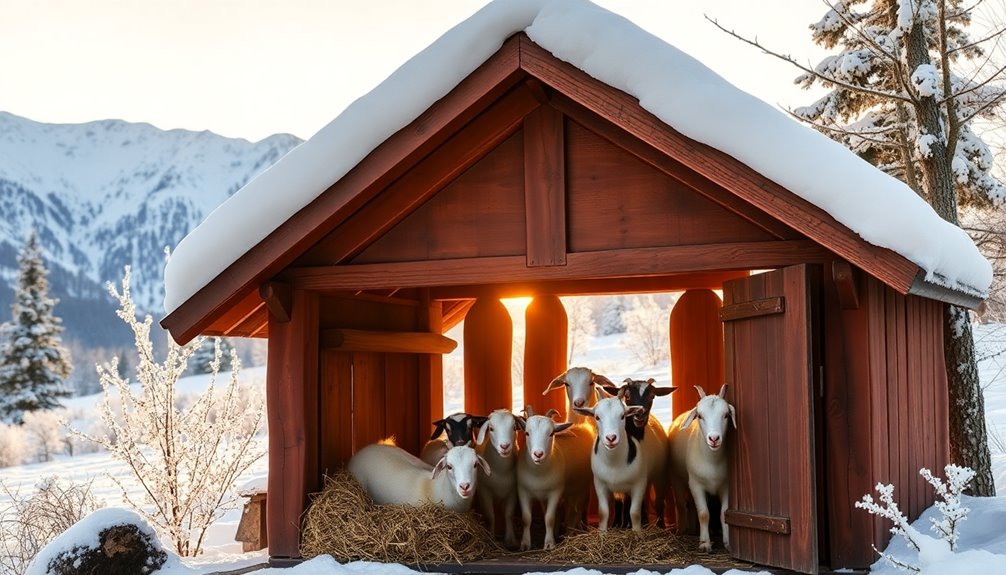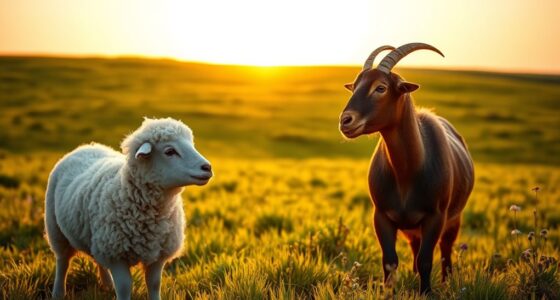Roosters usually start crowing between 4 to 5 months old, which marks a key developmental milestone. However, some breeds, like bantams, can begin as early as 2 months, while others might not crow until 8 or 9 months. Factors like genetics, breed traits, and social dynamics within your flock also influence when crowing starts. Environmental triggers, including seasonal changes and the presence of other roosters, can increase crowing behavior. Understanding these aspects can help you manage your flock better and appreciate their unique ways. Stick around, and you'll uncover even more insights about roosters and their behavior!
Key Takeaways
- Most roosters typically start crowing at 4-5 months, although some breeds may crow as early as 2 months or as late as 8-9 months.
- Breed and genetics significantly influence crowing age; fast-maturing breeds usually begin around 4-5 months, while bantams can start at 4 weeks.
- Environmental factors like seasonal changes and the presence of other roosters can stimulate increased crowing, especially during spring.
- Crowing serves various purposes, including establishing dominance and maintaining flock communication, reflecting the social dynamics among roosters.
- Managing crowing behavior involves monitoring frequency and integrating new roosters strategically to maintain flock harmony and reduce aggression.
Age of First Crowing
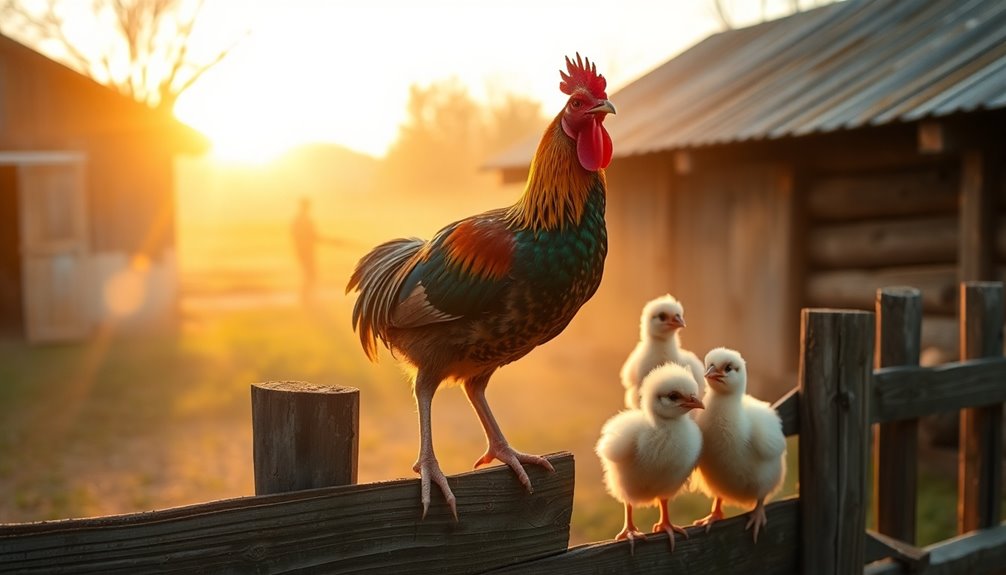
At around 4 to 5 months, most roosters start crowing, marking a key milestone in their development. This vocalization often signifies that they're reaching maturity and asserting their presence in the flock.
Curiously, some roosters might surprise you by starting as early as 2 months, especially if they belong to fast-maturing breeds like bantams, which can crow at just 4 weeks old.
However, don't be alarmed if you find that some of your roosters remain silent for almost a year. Individual development rates can vary greatly, influenced by factors like maturity and social dynamics within the group.
You'll often notice that the growth of saddle feathers and comb coincides with the onset of crowing, signaling a shift into adulthood.
Environmental factors also play a role. If your roosters are exposed to other crowing roosters or seasonal changes, you might see an earlier onset or increased frequency of crowing.
Understanding these variations can help you better appreciate the unique development of each rooster in your care. So, keep an eye on them—you'll have your own crowing chorus before you know it!
Influence of Breed
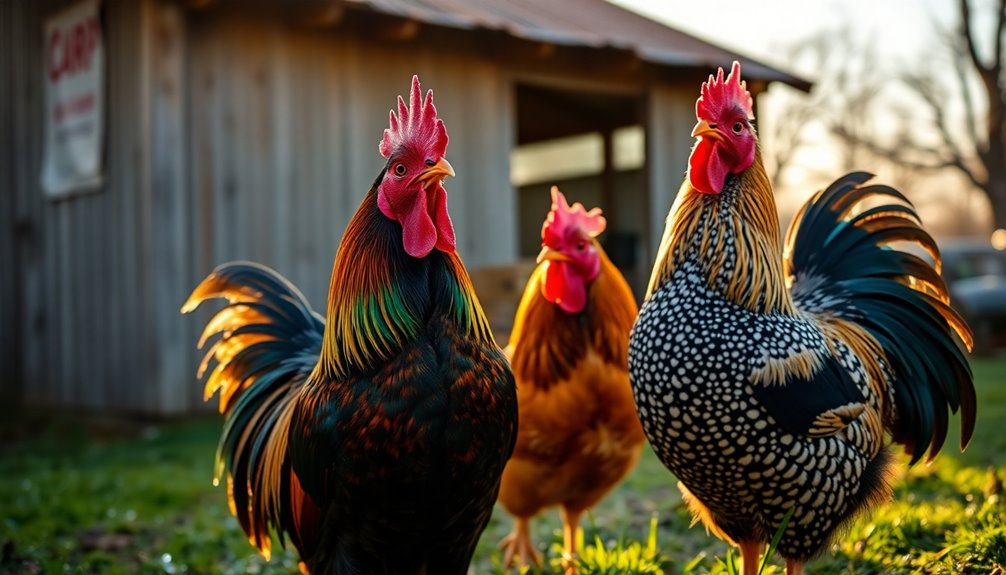
The breed of your rooster plays a significant role in determining when it starts to crow. Fast-maturing breeds, like Cochins, typically begin crowing around 4-5 months old, while bantam roosters, known for their smaller size, can start as early as 4 weeks. This quick maturation process sets them apart from standard breeds.
Each breed has unique characteristics that not only dictate the age at which your rooster will crow but also influence its overall behavior, including mating and social interactions.
Variations exist among breeds, with some roosters taking as long as 8-9 months old to begin their crowing. Factors such as genetics and environmental influences come into play.
Additionally, you might notice that the presence of other roosters in the flock can affect when your rooster feels the urge to crow. Social dynamics are vital; a confident rooster may start crowing earlier, while a more submissive one might delay.
Understanding your rooster's breed will help you set expectations regarding its crowing habits and behaviors, allowing you to appreciate the unique traits that come with each variety.
Behavioral Triggers
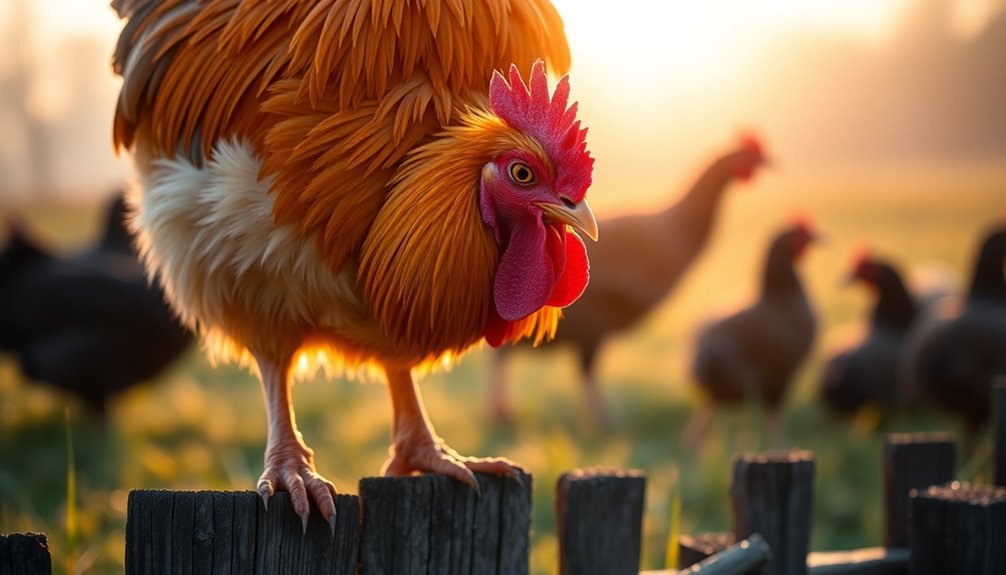
Understanding what triggers a rooster's crowing can help you manage your flock better.
You'll notice that factors like the dominance hierarchy, environmental changes, and social interactions all play key roles in this behavior.
Dominance Hierarchy Impact
In a flock of chickens, the dominance hierarchy plays an essential role in determining which roosters crow most frequently. Higher-ranked roosters assert their position through vocalizations, while younger cockerels often hold back to avoid conflict with their more dominant counterparts. This pecking order directly influences crowing behavior, as interactions among roosters can stimulate vocalizations.
| Rank | Behavior |
|---|---|
| High Rank | Frequent crowing |
| Mid Rank | Occasional crowing |
| Low Rank | Rarely crows |
When multiple roosters are present, you'll notice an increase in crowing as they establish their place within the social hierarchy. Conversely, if there's a lack of competition or fewer roosters around, lower-ranking individuals may become quieter, leading to diminished vocalization. Understanding this dynamic not only highlights the importance of the dominance hierarchy but also illustrates how the pecking order shapes the social interactions among roosters. So, if you're observing a flock, pay attention to these behaviors—it's a fascinating glimpse into their social structure and communication!
Environmental Stimuli Influence
Observing how environmental stimuli influence a rooster's crowing behavior reveals a dynamic interplay between nature and instinct. Your rooster's internal clock synchronizes with seasonal changes, often leading to increased crowing in spring when hormonal shifts occur.
If you keep your rooster in a free-range environment, you may notice more frequent crowing, as competition with other roosters can stimulate vocalizations. Disturbances like vehicle sounds or the presence of other animals can also trigger a crowing response, showcasing your rooster's alertness to potential threats.
When housed indoors during colder months, however, your rooster might miss out on opportunities to crow, which can impact its natural vocal behavior compared to those raised outdoors.
Additionally, if other roosters are nearby, you might witness competitive crowing, where they engage in vocal battles to assert dominance and communicate within their social hierarchy.
Social Interaction Dynamics
How do social interactions shape a rooster's crowing behavior? The social dynamics within a flock play an essential role in determining when and how often rooster crows. Dominant roosters often crow more frequently to assert their dominance and mark their territory. When you observe a group of roosters, you'll notice that competition can lead to increased vocalizations, especially among males trying to attract hens.
Here's a breakdown of the factors influencing crowing behavior:
| Factor | Influence on Crowing |
|---|---|
| Dominance | More frequent crowing |
| Competition | Stimulates increased vocalizations |
| Young Cockerels | May refrain from crowing |
| Communication | Signals presence to flock members |
| Environmental Disturbances | Triggers spontaneous crowing |
Understanding these dynamics helps explain why some roosters are more vocal than others. As they navigate their social hierarchy, their crowing becomes an essential communication tool, reinforcing their status and ensuring their presence is known within the flock.
Environmental Factors
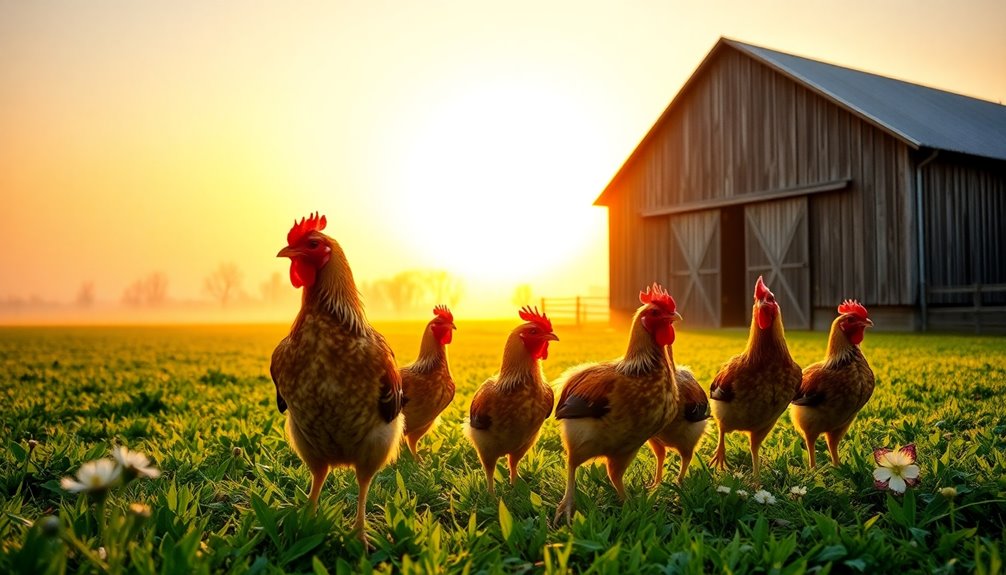
Roosters' crowing behavior is heavily influenced by environmental factors that shape their daily routines and vocalizations.
Seasonal changes play a significant role; for instance, roosters will crow more during spring due to hormonal shifts that trigger increased vocalization. When raised indoors during colder months, roosters may have limited opportunities to express themselves, while free-ranging in warmer weather encourages their natural crowing instincts.
Additionally, the presence of other roosters can stimulate competitive crowing. Interacting with peers often leads to more vocalizations, as they respond to each other's calls.
However, as fall and winter approach, you may notice a decrease in crowing frequency. This change happens because roosters react to shorter daylight hours and cooler temperatures, which can dampen their vocal enthusiasm.
Environmental disturbances, like sudden noises or perceived threats, can also prompt unexpected crowing at any time of day, even during the night.
Developmental Milestones
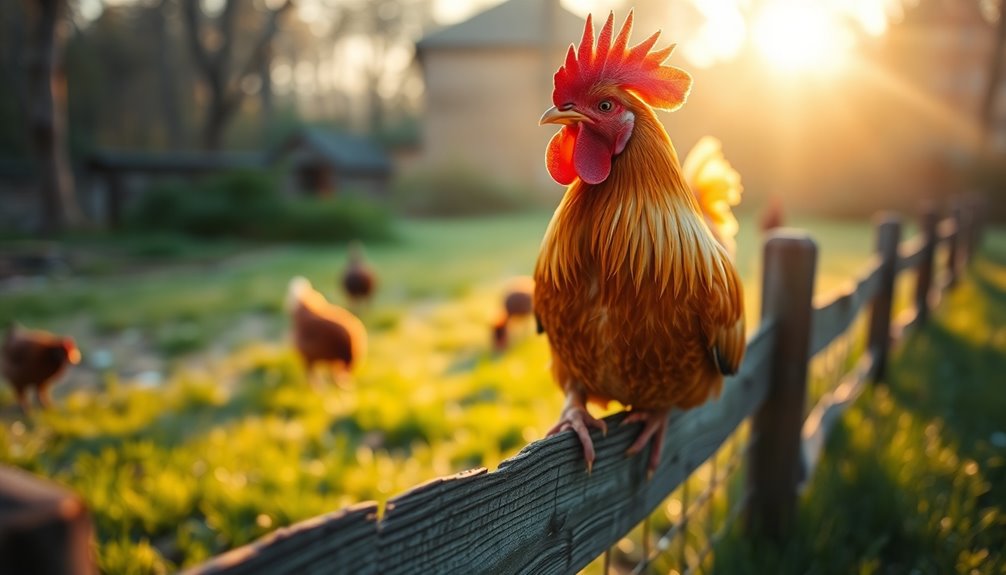
Crowing marks an important developmental milestone for roosters, typically beginning around 4-5 months of age as they reach physical maturity. At this stage, you'll notice the development of saddle feathers and a more pronounced comb, signaling that your rooster is ready to start vocalizing.
Initially, their crowing attempts might sound like a wheeze or exhalation, but over days to weeks, that sound evolves into the familiar "cockle-doodle-do" we all recognize.
It's fascinating to note that some roosters may start crowing as early as 2 months, while others mightn't crow until they're 8-9 months old. This variation highlights the individual differences in development you can expect.
The crowing behavior not only confirms a rooster's sex during its juvenile stages but can also indicate assertiveness.
If you've got a rooster that starts crowing early, be prepared for possible management decisions regarding their integration into flocks or living arrangements, as this behavior can affect social dynamics.
Recognizing these developmental milestones will help you better understand your rooster's growth and needs.
Reasons for Crowing
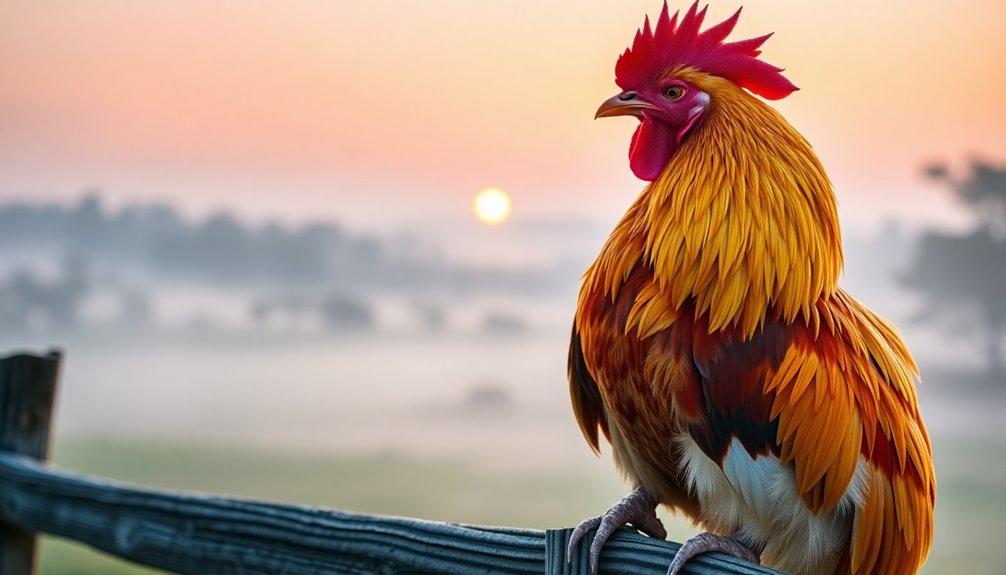
The sounds a rooster makes carry significant meaning beyond mere noise. As your rooster starts to crow, you'll notice it's not just a random occurrence; there are specific reasons behind those vocalizations.
Here are four key reasons why roosters crow:
- Establishing Dominance: Crowing asserts their position within the flock, signaling to other males who's in charge.
- Territorial Claims: Roosters crow to declare their territory, warning off potential intruders and maintaining their claimed space.
- Feeding Times: When food is available, a rooster will crow to assert ownership, ensuring he stays atop the pecking order.
- Social Interaction: Crowing also facilitates communication among flock members, helping to establish and reinforce social hierarchies.
Typically, you'll hear these vocalizations within months of a rooster starting to mature.
Beyond attracting hens, these crows reflect the complexities of rooster social dynamics. Understanding these reasons not only enhances your appreciation for their behavior but also helps you better manage your flock's interactions.
Managing Crowing Behavior
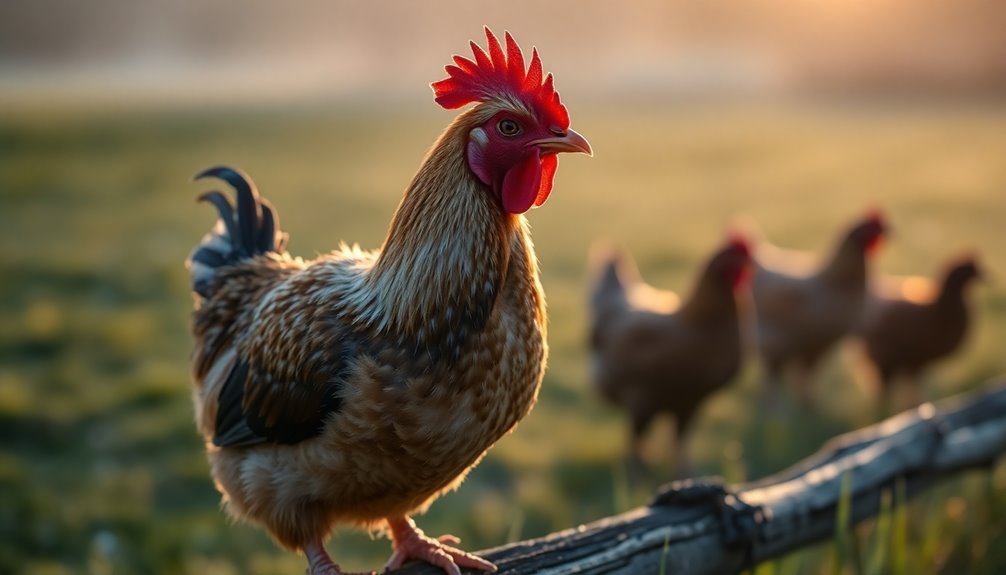
To manage your rooster's crowing behavior effectively, start by monitoring how often and when they crow.
If you have multiple roosters, consider integration strategies to reduce competition and minimize noise.
With the right approach, you can keep your roosters without upsetting your neighbors.
Crowing Frequency Monitoring
Monitoring crowing behavior is essential for maintaining a well-balanced flock. By keeping track of crowing frequency, you can identify which roosters start to assert dominance and spot potential conflicts early on.
Here are some tips for effective crowing frequency monitoring:
- Observe Patterns: Regularly watch your roosters during the day. Note when and how often they crow, especially during mating seasons or when other roosters are nearby.
- Separate When Necessary: If you notice early crowing, it may be time to separate roosters from hens to avoid aggressive behavior or unwanted mating.
- Manage Numbers: Too many roosters can lead to increased crowing. Keep your flock balanced to guarantee a harmonious environment.
- Consider No-Crow Collars: If you live in a residential area, a no-crow collar can help reduce crowing frequency and volume, allowing you to keep your roosters without disturbing neighbors.
Rooster Integration Strategies
How can you smoothly integrate new roosters into your flock while managing their crowing behavior? Start by observing the social dynamics to minimize aggression.
Establishing bachelor groups for younger roosters can be one of the most effective rooster integration strategies; this allows them to develop social skills without the stress of competing for dominance.
When you introduce new roosters, do it during low-stress periods, like after feeding. This approach helps ease their adaptation and reduces the likelihood that they'll crow all day long due to stress.
Pay close attention to their crowing patterns; increased crowing can signal challenges within the flock's social structure.
If you notice excessive crowing, consider using a No-Crow Rooster Collar. This tool can help manage their vocalizations and make it easier to keep them in residential areas without disturbing your neighbors.
Ultimately, by carefully monitoring their interactions and taking proactive steps, you can successfully integrate new roosters while keeping their crowing behavior in check.
Benefits of Roosters
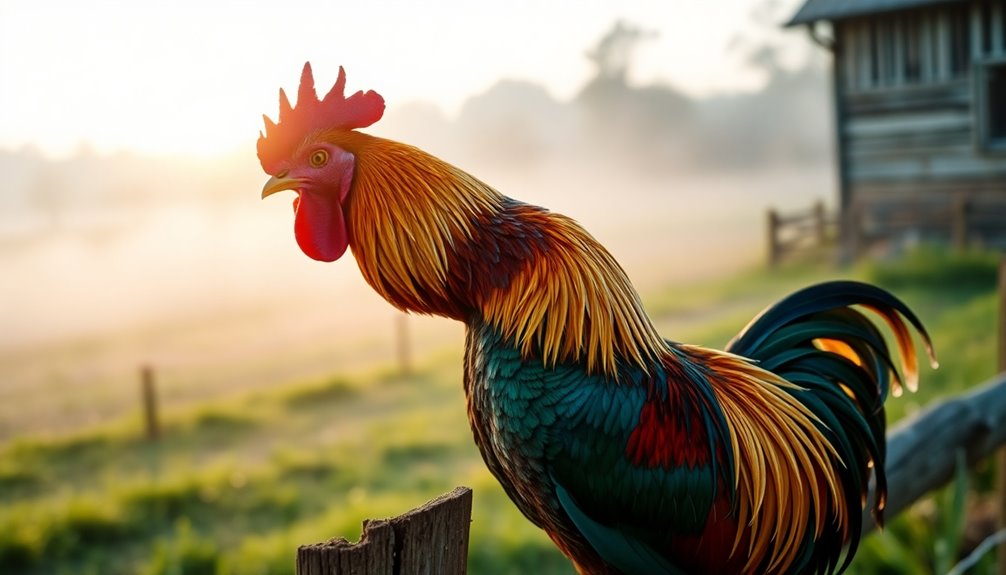
The charm of rural life often finds its voice in the crowing of roosters, which brings a unique atmosphere to any farm.
Beyond their delightful sounds, roosters are crucial for a healthy backyard flock. Here are some key benefits that make them precious to your setup:
- Protectors of the Flock: Roosters act as guardians against predators, ensuring the safety and well-being of your hens.
- Stress Reducers: Their presence helps lower stress levels among hens, leading to better egg production and overall flock robustness.
- Social Cohesion: Roosters aid in integrating new chickens and maintaining order within the flock, which minimizes fighting and promotes harmony.
- Vocal Development Observation: Watching young roosters as they learn to crow offers a unique insight into their growth and social interactions.
Incorporating a rooster into your backyard flock not only enhances the ambiance but also fosters a nurturing environment for your hens. Additionally, roosters can contribute to a thriving ecosystem by attracting beneficial bee populations, which play a vital role in pollination and maintaining the health of your garden.
With their protective instincts and social skills, roosters truly enrich the dynamics of your feathered family.
Frequently Asked Questions
At What Age Will Roosters Start Crowing?
Roosters usually start crowing around 4 to 5 months old, but some may surprise you by starting as early as 2 months.
Keep an eye on their saddle feathers and comb growth, as these often indicate maturity.
Remember, individual roosters develop at different rates, and environmental factors can play a big role.
What Triggers a Rooster to Crow?
Did you know roosters can crow up to 20 times in a single morning? Various triggers prompt this behavior.
You'll notice they often crow in response to the presence of other roosters, which fuels competition and establishes hierarchy.
Seasonal changes, especially in spring, also stimulate crowing due to hormonal shifts.
Additionally, unexpected noises or movements can provoke a crow as they alert their flock to potential threats, showcasing their role as protectors.
At What Age Do Roosters Get Mean?
Roosters can start to show aggressive behaviors as early as 4-6 months old.
At this age, they're maturing and often feel the need to establish dominance within their flock. You might notice them becoming more competitive, especially if other roosters are present or space is limited.
Their temperament varies by breed, so keep an eye on how they interact with hens and each other to gauge their aggression levels.
At What Age Do Roosters Look Like Roosters?
You'll notice young roosters start to look like adults around 4 to 5 months old.
That's when their comb and wattles begin to develop, adding to their mature appearance. Coincidentally, they also grow saddle feathers at this time, accentuating their look.
By 6 months, they'll stand tall, showcasing their larger size.
You'll see vibrant plumage as they shift from juvenile to adult, making it easier to identify them among the flock.
Conclusion
To summarize, knowing when roosters start crowing can enhance your experience with these fascinating birds. Did you know that a rooster's crow can be heard from up to a mile away? This impressive range not only showcases their vocal abilities but also serves as a natural alarm for their flock. By understanding the triggers and behaviors that lead to crowing, you can better appreciate the role roosters play in farm life while managing their crowing effectively.

